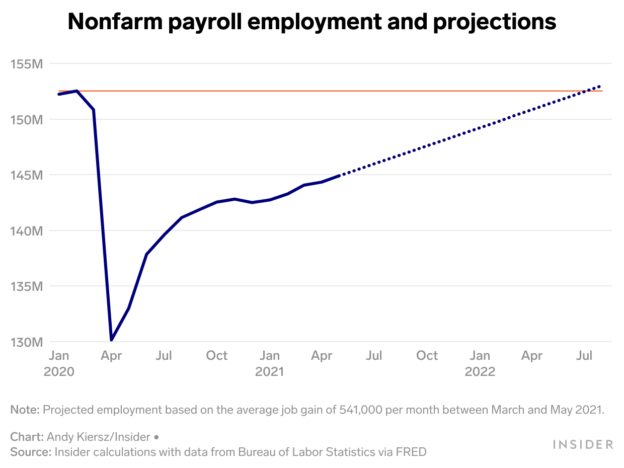At the May rate of job creation, it will take another 15 months to recoup all jobs lost during the pandemic.
Making up for more than a year of lost job growth would delay a full recovery to July 2023.
Economists expect hiring to accelerate as unemployment benefits expire and vaccination continues.
See more stories on Insider’s business page.
Hiring sharply rebounded last month after unexpectedly slowing in April. But there’s still more than a year of progress to be made.
The US economy added 559,000 nonfarm payrolls in May, according to government data published Friday morning. The unemployment rate fell more than expected, to 5.8% from 6.1%, and the average wage surged for the second consecutive month.
The report marks a fifth straight month of job additions and a strong pick-up from the 278,000-payroll jump seen in April. Yet while some gauges of economic activity, such as retail sales and factory activity, have staged V-shaped recoveries, the labor market remains far from retaking its pre-pandemic highs.
Just how far from a complete recovery depends on how one tracks the job-creation trend. If payroll growth holds steady at a monthly rate of 559,000, US jobs will surpass the pre-pandemic peak in July 2022.
But monthly employment data is volatile, and counts are frequently revised in subsequent reports. Taking the three-month average of monthly job growth pushes a full recovery slightly further into the future, with the US recouping all lost payrolls sometime in August 2022.
Even then, the country will only have returned to the payroll figures seen in early 2020. Monthly job creation averaged 197,000 before the pandemic, and the health crisis swiftly ended that rate of expansion. At the May rate of payroll growth, it would take until July 2023 to catch up to the pre-pandemic trend, Nick Bunker, the economic research director at Indeed, said in a tweet.
The labor shortage and the rehiring pushOther data suggest the rebound could take even longer. Sectors hit hardest by the pandemic added the most jobs in May, continuing a trend seen throughout the recovery. Yet many businesses have reported difficulties in filling openings. Just 1.4 available workers exist for every job opening, half the average seen over the past 20 years.
Once the easy gains are made, the labor-shortage phenomenon could drag on hiring, Bank of America economists said Friday.
“There is little question that the demand for workers is robust given the record-high job openings rates. But for a variety of reasons, the supply of labor is constrained, holding back job growth particularly in the lower-income and low-skilled sectors such as leisure and hospitality and retail,” the team led by Michelle Meyer said in a Friday note.
To be sure, a steady acceleration of wage growth could counter the shortage. Taken together, the pay growth seen in April and May is the fastest since 1983, barring an early-2020 spike skewed by the start of nationwide lockdowns. It seems businesses are paying up to ensure they rehire before their competitors.
Other deadlines could soon bring sidelined Americans back into the workforce. Economists have highlighted childcare costs and virus fears as critical obstacles keeping people from work. The new school year and continued vaccination should ease those pressures and help the labor shortage fade through the fall,
Federal Reserve
Governor Lael Brainard said in a Tuesday speech.
The expiration of enhanced unemployment insurance should have a similar effect, she added. Half of all US states are poised to end the federal government’s $300-per-week boost to UI early, and the rest of the country will see the benefit lapse in September. President Joe Biden backed the September deadline on Friday, saying such policy “makes sense.”
Republicans began criticizing the weekly boost after the disappointing April jobs report, saying the benefit kept Americans from seeking work. While research suggests the disincentive effect was minor, the expiration of enhanced UI is largely expected to further offset the labor shortage and pull more Americans into the workforce.
Loading
Something is loading.
More:
Economy
Labor Market
Labor market data
Economic Data
Chevron icon
It indicates an expandable section or menu, or sometimes previous / next navigation options.

Comments are closed